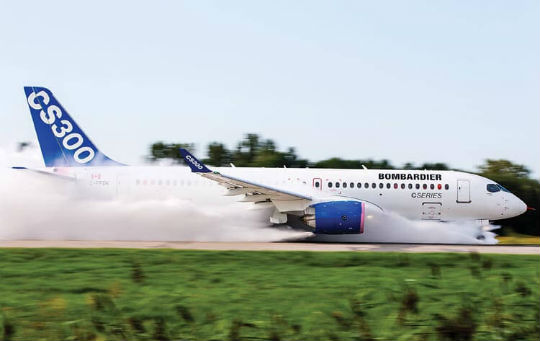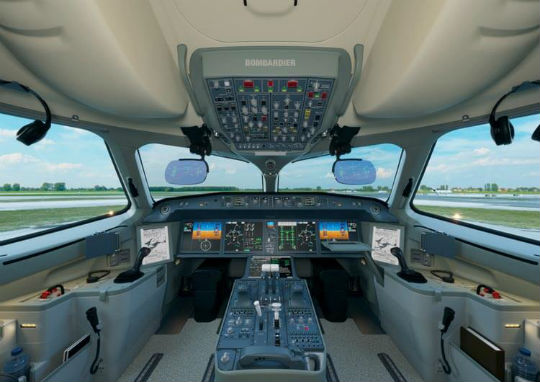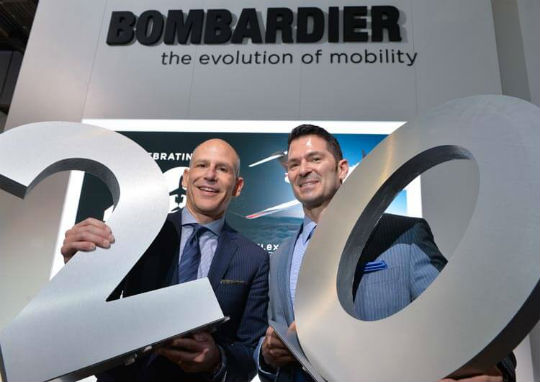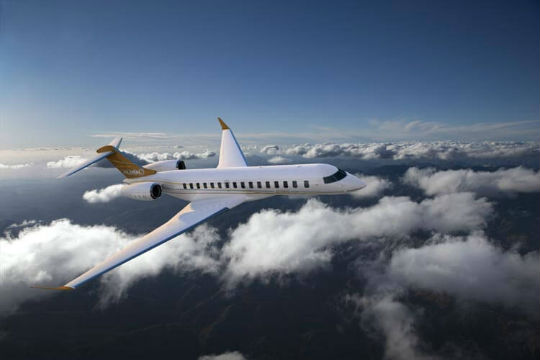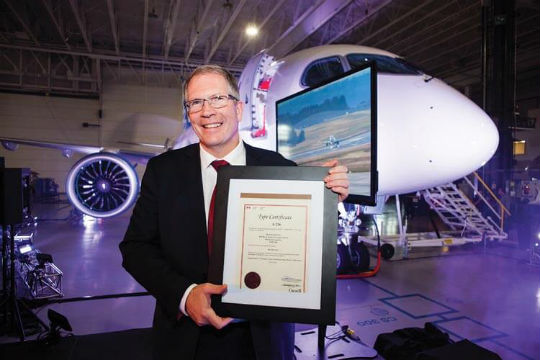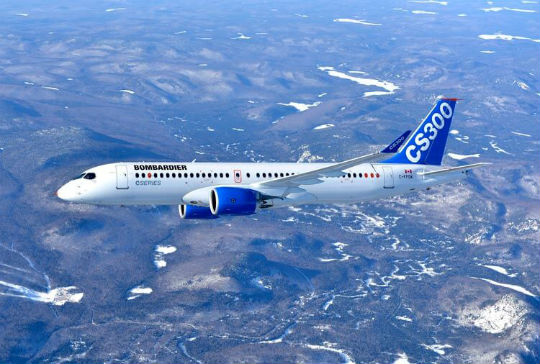Bombardier’s C Series program celebrated a big milestone on Dec. 18, 2015, when the CS100 aircraft received Transport Canada type certification. The stage is now set for the clean sheet jet’s entry into service with launch customer, Swiss International Air Lines, in mid-2016. Patrick Cardinal Photo
The Quebec government’s US $1 billion lifeline to Bombardier Inc.’s C Series jet program comes at a crucial time for the plane manufacturer.
The announcement in late October that Quebec has become a partner in the C Series sets a cautiously optimistic tone for 2016 at Bombardier, particularly after the C Series received Transport Canada type certification on Dec. 18, 2015, setting the stage for its entry into service later this year.
Bombardier chief executive officer Alain Bellemare said he has been carefully studying what needs to be done to improve operations since he became CEO in February 2015.
The 135-seat CS300 is currently undergoing its own certification process, including water ingestion testing, shown here in August 2015. Patrick Cardinal Photo
“As you’ve seen over the past few months, we took several key actions to de-risk and stabilize the business,” Bellemare said during the company’s investor day conference in New York in late November. “We have developed a five-year strategic plan to drive superior performance across all of our businesses.”
Delays have plagued the C Series ever since the company formally started development of the narrow-body, single-aisle jet aimed at the 100 to 150-seat market.
The 110-seat CS100 version completed certification flight testing in November. The regional aircraft’s launch customer will be Swiss International Air Lines, which is expecting delivery of its first CS100 by mid-2016.
The C Series’ integrated avionics suite includes large LCD displays as well as dual flight management systems (FMS). The flight deck also features sidestick controls. Bombardier Photo
The 135-seat CS300 version’s launch customer will be Air Baltic, though that larger plane needs to go through its own battery of tests before deliveries are slated to begin in the second half of 2016.
For a jet program clouded by uncertainty during much of its history, talk about C Series deliveries has been a long time coming. Getting to this point has been financially painful for Bombardier, which recently had US $6.5 billion in net debt. In its third-quarter results in 2015, Bombardier took a US $3.2 billion writedown related to the costs of developing the expensive C Series program. The company also absorbed a US $1.2 billion charge related to cancelling its Learjet 85 aircraft.
But Quebec’s new investment of US $1 billion gives the province a 49.5 per cent stake in the C Series joint venture. Politically and economically, the stakes are high. The C Series program employs nearly 1,700 workers across Quebec.
“2016 will be a year of transition,” said Bellemare, who replaced Pierre Beaudoin as CEO. “We have a great workforce. We have people with great expertise and our employees are proud and passionate about Bombardier.”
Beaudoin’s father, Laurent, is the son-in-law of the firm’s late founder, Joseph-Armand Bombardier. Pierre Beaudoin serves as the company’s executive chairman and his father is chairman emeritus.
To date, WestJet and Air Canada have not ordered the C Series. WestJet opted in 2013 to order 65 Boeing 737 MAX aircraft, shown here. Boeing Image
At the end of November, Montreal-based Bombardier had 243 firm orders for the C Series, comprising 53 orders for the CS100 and 190 for the CS300. The goal is to reach at least 300 firm orders by the time the CS100 enters commercial service.
Sales dried up between the fall of 2014 and late 2015, but company executives see the potential to sell up to 3,500 C Series planes between inception and 2034, or roughly half of the market envisaged for the 100 to 150-seat jet market over a 20-year period.
A Pratt & Whitney engine helps provide a competitive advantage for the jets assembled at Mirabel, Que., Bombardier executives say. They point out that the two C Series versions share 95 per cent parts in common.
The C Series, which incorporates lightweight composite materials, is being promoted as a quieter jet that has lower emissions when compared with rivals, notably the Embraer E195 and Boeing 737-700.
But Boeing has been touting its 737 MAX while Airbus promotes its A319neo. Each of those larger-capacity planes boasts thousands of firm orders. That’s far ahead of the C Series, though they are not direct competitors. Depending on the model and configuration, the 737 MAX typically seats from 126 to 220 passengers, while the A319neo can seat 160 to 240 travellers.
The business aircraft side of the Bombardier house has had some recent wins. At NBAA 2015, for example, Flexjet LLC exercised options for 20 additional Challenger 350 business jets from Bombardier Aerospace. The operator has now placed firm orders for 40 of the super-midsized business jets. Here, Michael Silvestro, Flexjet’s chief executive officer, left, and David Coleal, president, Bombardier Business Aircraft, celebrate the order. Bombardier Photo
Toronto-based Porter Airlines Inc., the operator of Bombardier Q400 turboprops, placed a conditional order in 2013 for 12 CS100s. But it’s unclear whether the regional carrier will be able to operate the jets at Billy Bishop Toronto City Airport. Marc Garneau, the new federal Transport Minister, has said Ottawa doesn’t want to reopen a “tripartite agreement” signed in 1983 by the Toronto Port Authority, the City of Toronto and the federal government. That agreement dictates which types of aircraft can be flown to and from the Toronto island airport, and jets are not allowed under the pact.
Porter has grown rapidly since launching in 2006, deploying Q400s assembled at Bombardier’s Downsview plant in Toronto. Industry observers don’t think it makes sense for Porter to fly the C Series from Toronto’s Pearson International Airport because the regional carrier has relied on Billy Bishop’s strategic location near Toronto’s downtown core as a main selling point for consumers.
While Ottawa appears to have delivered a blow to Porter’s growth strategy with the C Series jets at the Toronto island airport, Bombardier is still hoping that Prime Minister Justin Trudeau’s Liberal government will provide some form of cash injection for the plane manufacturer.
In November, the Caisse de dépôt et placement du Québec (CDPQ) announced a US $1.5 billion deal for a 30 per cent interest in passenger train-making unit Bombardier Transportation. The public pension fund’s decision to invest is a welcome sign for Bombardier as a whole.
A mock-up of Bombardier’s luxurious Global 7000 long-range business jet was displayed at NBAA 2015. The jet features four distinct zones for business and pleasure. See the Skies Global 7000 video here. Bombardier Image
“We believe the company has shored up its finances as it continues to focus on the introduction of the C Series and the Global 7000/8000 program with adequate liquidity now in place to see these programs through to fruition,” AltaCorp Capital Inc. analyst Chris Murray said in a research note.
Murray said he believes it is a question of when and not if new C Series orders will be announced, and that 2016 will be a critical juncture. “Management remains selective of C Series customers, preferring to target mainline carriers which should provide an impetus to further sales rather than leasing companies,” Murray said.
He cautioned, however, that business aircraft revenue will be eroded by the decline in production rates for Global 5000/6000 jets.
While the spotlight is on the C Series passenger aircraft, Bombardier continues to forge ahead on developing the Global 7000/8000 series and Challenger 350 business jets.
The Global 7000’s entry into service is slated for 2018, followed by the 8000 potentially in 2019, industry observers say. Those two long-range business jets can seat eight to 19 passengers, depending on the cabin configuration.
Flexjet LLC of Texas signed a memorandum of understanding with Bombardier in November to buy 20 Challenger 350 private jets, which each seat nine passengers. Flexjet said the latest announcement boosts the number of its firm orders to 40. Deliveries from the original order for Challenger 350s started in January 2015, said Flexjet, which provides fractional jet ownership and leasing.
Rob Dewar, Bombardier’s vice president, C Series aircraft program, displays the Transport Canada CS100 type certificate that was presented to the company on Dec. 18, 2015. Patrick Cardinal Photo
National Bank Financial Inc. analyst Cameron Doerksen said Bombardier still has significant financial commitments ahead associated with supporting the Global 7000 program, on top of devoting cash for ramping up production of the C Series.
The emergence of the Quebec government and CDPQ have bolstered the outlook for the C Series, but the program is far from entering an easy phase, especially with hefty investments still required on the production line. Development costs are already pegged at US $5.4 billion, or almost 60 per cent higher than originally envisaged.
Doerksen said he still has concerns about the business jet market and emphasized that Bombardier is still on the hunt for more C Series customers. The company hopes to ramp up to a production rate of 90 to 120 of the jets per year, beginning as early as 2020.
Bombardier chief financial officer John Di Bert added that even if 2016 proves to be more difficult than anticipated, the company will be in good financial shape, helped by Quebec and CDPQ. “We’ll navigate 2016 and we’ll gain momentum through ’17,” he said. Longer term, he forecasts total revenue exceeding US $25 billion by 2020, or an annual growth rate of five to six per cent, assuming success with the C Series and new Global series.
At the end of November, Bombardier had 243 firm orders for the C Series, comprising 53 orders for the CS100 and 190 for the CS300. Rick Radell Photo
RBC Dominion Securities Inc. analyst Walter Spracklin said there were low expectations heading into Bombardier’s investor day conference in late November. Nevertheless, the presentations by Bombardier’s new management should help restore confidence in the company’s efforts to strength its commercial and business jet programs. The tone is now setting realistic targets, in contrast to unattainable goals touted in the past, Spracklin said.
There are “competitive headwinds still weighing on the firm’s core aerospace business, lingering execution risks associated with the company’s flagship C Series program,” Raymond James Ltd. analysts Steve Hansen and Ben Cherniavsky said in a November research note. In subsequent comments, after listening to Bombardier’s presentations, they said CS100 testing has produced strong results.
“Testing performance has also been impressive, with the CS100 surpassing many of its key design targets, including range, fuel burn, passenger capacity, noise and its fully loaded cash-operating cost advantage estimate,” they wrote.
With 15 to 20 C Series planes expected to be delivered in 2016, many more orders are needed to strengthen Bombardier’s strategy to break even on cash flow for the C Series in 2020 or 2021. Plans call for another 30 to 35 C Series jets to be delivered in 2017, followed by 45 to 55 in 2018. “Bombardier maintains it has secured 47 per cent of the 100 to 150 seat target market since launch, and reports a surge in active interest, given recent milestones. Time will tell,” according to the Raymond James analysts.
SWISS will replace its fleet of short-haul Avro RJ100s with Bombardier’s CS100 in 2016. Later, the airline will also take delivery of larger CS300 aircraft. Andy Cline Photo
Air Canada and WestJet Airlines Ltd. have not placed any C Series orders. WestJet opted in 2013 to place orders for the Boeing 737 MAX, with deliveries set to start in 2017. Air Canada has been disciplined with its capital spending, deciding last year to reconfigure its existing 777 fleet.
Bombardier Commercial Aircraft president Fred Cromer said he has witnessed his share of economic ups and downs in the aviation industry over the past couple of decades. “We will leverage the strong incumbent market position and success of the CRJ and the Q400 programs to deliver the C Series,” he said during the investor conference webcast from New York. “We understand what needs to be done and we have a plan to put us on the road to profitability.”
Amid the pressure, Bombardier executives are pleased to see milestones achieved, including the completion of flight testing for the CS100 in November.
“I heartily congratulate the many employees, suppliers and customers that have worked together to bring us all to this important milestone,” Cromer said in a statement.
Small victories count in the long journey of the C Series program, which has endured its share of setbacks in the years after Bombardier officially launched plans for the fuel-efficient jet in 2008.
Brent Jang, a business reporter at The Globe and Mail, is the winner of two National Newspaper Awards and has been a National Magazine Award nominee. Over the years, he has staffed the Farnborough International Airshow and boarded an Airbus A380 jumbo jet for a test flight from Montreal to Paris.

